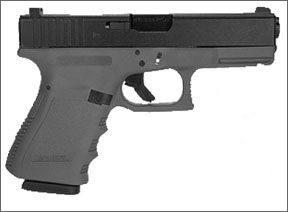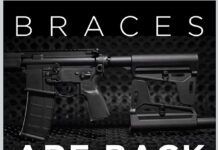Best in Class: PISTOLS
Glock Model 23 .40 S&W
No. HXL616, $670
Reviewed: June 2006
The Model 23 is the midsized model in the Glock lineup. It follows the same design and configuration as all the other Glock pistols, the majority of which feed from a double-column magazine. The grip frame of the 23 was shorter than the full-size model 22. According to Glock, 10-, 13-, and 15-round magazines are available. Our Model 23 arrived with three 13-round magazines and Trijicon night sights. The frame was colored O.D. green, and the underlug was molded to provide a Picatinny rail with one cross cut. The only external controls, save the combination trigger and passive safety, was the slide release and the magazine release, each on the left side only. The theme here was to produce a slick-bodied, snagproof pistol. Even the latch to remove the slide was countersunk. The grip showed a mild palm swell to the rear and three finger grooves on the front. The trigger guard, which was squared and checkered at the front, was also undercut where it met the front strap. The magazine release was abbreviated to avoid accidental operation.
To field strip the gun, we pushed the slide to the rear about one-quarter inch and pulled down simultaneously on the sliding locks found above the trigger guard on both sides of the frame. Moving the slide forward, it moved easily off of the frame. To reinstall it, we simply fitted the slide and frame together. The latches lock automatically. With the frame removed, we noticed that the barrel and slide were given additional support by a steel block placed directly behind the forward set of slide-to-frame contact points inlaid into the frame.

288
The Glock model 23 was the only pistol in the test that relied upon a striker for ignition. The Glock trigger is classified as full-time double action because it draws back the striker and releases it when maximum energy has been stored in the spring. The result was a longer trigger process than a single action.
When we shot standing unsupported, we held the Glock differently. The shooter’s wrist had to be canted forward so that the sights were level. Of course we also found that the Glock trigger required more movement than single-action shooters might suspect. But it also felt the same from shot to shot, and this helped us produce the most consistent rapid fire hits. In our low-light test, we were able to produce a clean 10-shot group measuring 3.5 inches across.
PISTOLS RUNNERS-UP
Guncrafter Industries
Model No. 1 .50 GI, $2895
Reviewed: January 2006
Alex Zimmerman took the custom 1911 world a giant step farther when he came up with the idea of a .50-caliber cartridge that would fit into the "footprint" of a 1911. Was it possible to get more "gun" into a 1911? Yes. Does the .50 GI indeed offer more? You bet it does!
The gun was extremely well made, and that’s only the first thing we noticed. We got some of the two available types of ammo from G.I. to try in the test gun. Ammo is $14.25 for 20 rounds of 300-grain JFP, or $15.75 for 20 of a hotter 275-grain JHP. While low-cost surplus ammo doesn’t exist, Guncrafter helps the shooter by offering reloading dies, brass, bullets, and reloading data from the company website (www.guncrafterindustries.com). Bullet diameter is 0.500 inch, same as used by the .50AE and .500 S&W Magnum. For the record, Linebaugh’s .50s use 0.510-inch bullets.
This pistol was one of the tightest-constructed 1911s we’ve inspected. The frame and slide were machined from forgings. The overall look was pure business, with olive-drab checkered aluminum grip panels contrasting nicely with the Parkerized steel. Lockup was with a slight click, more felt than heard, as the parts went together with zero rattles and zero slop. Unlike another makers’ guns that lock so tightly they need hundreds of rounds to break in, the .50 GI was pleasant right from the start. It took good strength to open the gun, and we found it easier to cock the hammer first, but it didn’t take a Schwarzenegger to get it open. We applauded the lack of a barrel bushing, and the fine fit evident at the rear of the slide. We noted the complete lack of loose parts, and that the metalwork, finishing and fitting everywhere were absolutely first class. The fixed sights had tritium inserts. There were no sharp edges anywhere to cut the hands of shooters practicing clearing drills, or to gouge your holster. Clearly, the maker understands fighting handguns.
The trigger was excellent, no surprise once we realized what a fine piece of work we had in our hands. The Videki-pattern trigger broke cleanly at 4.8 pounds, was well fitted in its slot, and was perfectly adjusted for overtravel. We had expected a heavy gun, but were happily disappointed. Yes, it was a touch heavier than a .45 ACP, 41.6 ounces empty versus 38 ounces. The handling, however, was identical. As we prepared to press the trigger of the .50 GI on a live round for the first time, we didn’t realize we were in for one of our finest surprises in many years of testing guns. We expected a nasty kick. It never happened. Instead, after a few rounds, we tried a series of double taps with the .50. To our joy, we could easily control it as easily as a .45. Our rounds landed exactly where we would have expected them to land with the .45 ACP. We were hooked! This gun had it all, we thought. It had significantly more power than the .45 ACP in an easily controlled package.
There are two "normal" loads for the .50 GI, one with a 300-grain jacketed flat-point bullet at a nominal 700 fps (actually 712), and a 275-grain JHP at a nominal 875 (actually 890). Our chronograph told us Guncrafter was honest in its velocity claims. The 275-grain load gave a touch more felt recoil, and did seem to have some muzzle flash, but in no way did we think either was objectionable. Accuracy was generally five shots touching at 15 yards.
Para-Ordnance SSP
.45 ACP PX745E, $899
Reviewed: May 2006
We function-fired the gun with a variety of ammunition, then loaded it with at least 200 rounds of a handload featuring the 200-grain lead-swaged bullet from Precision Bullets (precisionbullets.com) that offered molybdenum coating to minimize deposits. We recorded accuracy data at an outdoor range from a 25-yard bench rest with this round plus three factory loads. The Para-Ordnance SSP was the least expensive gun in our group, but many of our testers thought it was also the best looking. Stainless-steel colored accents included the hammer, grip safety, thumb safety, barrel, magazine release and slide stop. Stainless Allen screws held the colorful wood grips on. The black Para Kote frame and slide contrasted with these parts. After the test, we noted only minor holster wear at the forward tip of the slide. The economical SSP lacked front-strap checkering. Other cost cutting measures were house-design low-snag sights and the use of white dots fore and aft rather than name-brand night sights. But the SSP did include a full-length guide rod and a fully supported, ramped barrel. Field stripping was not markedly different from a short guide-rod model, and only a little more trying when putting the provided bushing wrench to use.
The Para-Ordnance SSP utilized a firing-pin safety controlled by the trigger in a similar manner to the Colt Series 80. The action of the safety, combined with the act of releasing the hammer, produced a soft let off. The slower we pressed the trigger, the more noticeable it became. The left side-only thumb safety showed some overtravel movement in the down position that was distracting at first, but did not affect function. The magazine well was beveled, but only slightly, and unfortunately there did not seem to be much material left to machine ahead of the checkered mainspring housing. (Adding a magazine guide that was pre-fit and contoured, such as part No. 185, $22 from
At the range our Para-Ordnance proved easy to shoot. Our handload averaged 2.8 inches for a five-shot group. The SSP handled the hot Speer rounds, printing an average group measuring 2.3 inches @ 997 fps. The Federal Hydra-Shoks landed average groups of 2.1 inches. The Para-Ordnance stood out with a 1.4-inch group firing the Atlanta Arms and Ammo Match rounds to produce an average group of 1.8 inches.
Walther P22
No. WAP22003 .22 LR, $301
Reviewed: February 2006
This was our first hard look at the 3.4-inch-barrel P22, and we really liked it. We thought it would give up accuracy to a longer-barrel P22, but that was not the case. In fact, we could see no reason at all to own the longer P22, which has the model designation No. WAP22005. Actually, if you have either one of these you can buy the barrel (about $100) for the other and convert it.
Out of the box, we thought the P22-003 was a great-looking little gun, all business. It fit the hand extremely well, but some thought the grip was too small in circumference. We tried the (included) thicker rear-grip insert, and liked it better.
The gun was a uniform matte black, but is also available in two-tone, or in "military" colors, with dark-green frame and black slide. There is also a carbon-fiber-frame version, which is supposed to be even lighter, and there is a suppressed version for those who need it and can legally own it. The frame was polymer, and the slide of aluminum. The grip panels were formed integrally with the frame, and had molded-in dots for traction. The gun had an ambidextrous safety, and could not be fired with the magazine out. The gun also had a clever internal trigger lock that could be activated with a key that came with the package. The magazine release levers were ambidextrous, so the gun was good for lefties. Some of the parts were sheet metal, but seemed to be adequately strong for their intended purpose. The slide serrations worked well. There were extra serrations on the front of the slide for press checking, and there was a chamber-inspection slot.
We could have done without the hook on the front of the trigger guard. The edges of the ejection port were razor sharp, the only sharp corners we found on the gun. We liked the sights, both the windage-adjustable rear and the replaceable plastic front. The sights had white dots and gave an excellent picture. Four different front-sight heights are available for fine tuning bulllet impacts with the P22.
Takedown was very much like that of the old PP. Clear the gun, cock it, and pull the takedown lever just above the front of the trigger guard all the way down. Then pull the slide to the rear, lift it, and ease it off the barrel to the front. The guts of the gun were mounted into an aluminum frame pinned within the polymer frame. Workmanship was excellent inside and out, we thought. Replacing the slide required the use of a small rod that came in the kit. Good luck getting the slide back in place if you lose that rod. We suggest making or securing a replacement before you lose the original.
On the range we had zero problems. We loved the trigger, which broke cleanly at about 4.4 pounds. The double-action pull was just 9 pounds and quite smooth. We tweaked the tiny adjustable rear sight for windage and got on target. No need to change the front sight. We tried several other types of ammunition, and the little Walther liked it all.
This is the sort of little .22 pistol we had in mind when we began looking for affordable plinking guns. The old aluminum-frame, 9-shot PPK/L is, we think, well replaced in today’s market with this very accurate little polymer pistol.




























